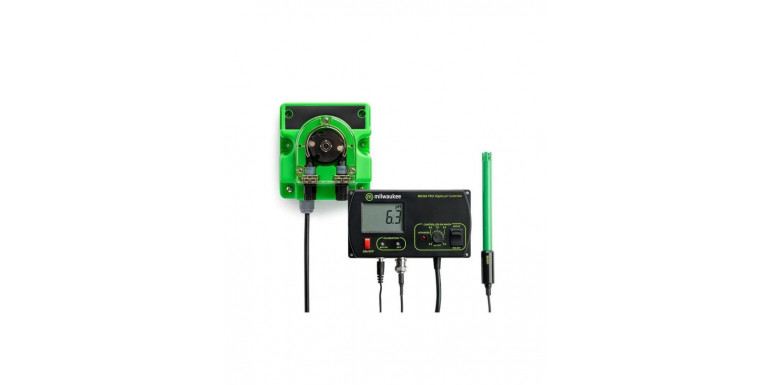
Part II: Measurement Tools for pH Control in Cannabis Cultivation
Chapter 1: Why Is It Important to Monitor pH in Soil and Nutrient Solution for Cannabis?
In cannabis cultivation, pH control is essential to ensure optimal plant growth and development. Cannabis is particularly sensitive to pH changes, which directly impact its ability to absorb nutrients. Therefore, regular monitoring of pH in soil or hydroponic systems is necessary to prevent nutrient deficiencies.
Optimal pH Levels for Cannabis
- In soil cultivation, the optimal pH range is between 6.0 and 7.0.
- In hydroponic or coco coir systems, the ideal pH range is between 5.5 and 6.5.
These values provide the best nutrient availability, such as nitrogen, phosphorus, and potassium, which are key for healthy cannabis growth. Exceeding these values can lead to "nutrient lockout," where the plant is unable to absorb nutrients even though they are present.
Consequences of Incorrect pH Levels
- Low pH (acidic) can lead to the toxic buildup of heavy metals like aluminum, negatively affecting root development.
- High pH (alkaline) can limit the availability of micronutrients such as zinc, iron, and manganese, resulting in deficiencies and slowed growth.
Chapter 2: Bluelab – A Leader in pH Measurement for Cannabis Cultivation
Bluelab offers ideal tools for monitoring pH levels, crucial in cannabis cultivation. Thanks to their precision and reliability, Bluelab tools allow growers to maintain stable growth conditions, minimizing the risk of nutrient deficiencies or lockout.
Key Bluelab Products
- Bluelab pH Pen – A compact tool for quick and accurate pH measurements in soil and hydroponic systems.
- Bluelab Combo Meter – A multifunctional device that measures pH, EC, and temperature, perfect for advanced growers.
- Bluelab pH Controller – A device that automatically regulates pH in hydroponic systems, providing constant control over conditions.
Chapter 3: How and When to Measure pH in Cannabis Cultivation
Monitoring pH is crucial at every stage of cannabis growth, as both too high and too low values can negatively impact the plant’s ability to absorb nutrients. To ensure the best growing conditions for your plants, regular pH measurements should be part of every grower's daily routine.
When Should You Measure pH?
- Before watering and fertilizing – Always check the pH of water or nutrient solution before watering or applying fertilizers to ensure it is within the optimal range.
- After adding fertilizers – Some fertilizers can alter the pH of the solution, so it’s a good idea to check the pH again after adding them. Even if the water had the correct pH, fertilizers might change it.
- Regular soil checks – In soil cultivation, regularly checking the soil’s pH can help ensure it remains stable, especially after intensive fertilization.
- After environmental changes – If you change the growing environment (e.g., new water source, different fertilizer), monitor the pH more frequently to ensure the plants aren’t stressed by pH fluctuations.
How to Measure pH Correctly?
- Use clean equipment – Make sure the pH probe or meter is thoroughly cleaned before each measurement to avoid contamination, which could affect accuracy.
- Calibration – Regularly calibrate your measuring tools according to the manufacturer’s recommendations (e.g., every two weeks or after about 30 measurements). Proper calibration is key to ensuring reliable results.
- Consistency – Always take measurements at the same time of day to ensure comparable results.
Proper pH monitoring minimizes the risk of plant stress and helps you better control their growth.
Chapter 4: How to Use Bluelab Tools in Cannabis Cultivation
Bluelab provides tools that make it significantly easier to monitor pH and other key parameters such as electrical conductivity (EC) and temperature. Here’s how to use these tools in your daily cannabis cultivation routine:
1. Bluelab pH Pen – Ideal for Quick Measurements
The Bluelab pH Pen is one of the most popular tools for cannabis growers who need quick and accurate results. It can be used for both soil and hydroponic solutions.
- Application: Simply immerse the probe in water, nutrient solution, or directly in the soil to get an instant pH reading. The pH Pen is convenient and compact, making it easily accessible at all times.
- Calibration frequency: Regular calibration every two weeks or after 30 measurements ensures the best results.
2. Bluelab Combo Meter – Comprehensive Parameter Control
The Combo Meter combines pH, EC, and temperature measurement, making it a great tool for more advanced growers who need to monitor several key parameters simultaneously.
- Application: With a single device, you can monitor three parameters, which is especially convenient in hydroponic systems where both pH and EC play crucial roles.
- Benefits: It allows for real-time monitoring of growth conditions, which is essential to maintain stable conditions throughout the entire growing cycle.
3. Bluelab pH Controller – Automatic pH Regulation
For growers using advanced hydroponic systems, the Bluelab pH Controller offers full automation of pH control.
- Application: This device continuously monitors pH and automatically adds pH adjusters when values drift outside the desired range. This ensures the pH stays at optimal levels without the need for constant manual intervention.
- Benefits: It saves time and minimizes human error, which is crucial for larger-scale grows.
Chapter 5: What Are the Optimal EC Levels for Cannabis Cultivation?
Electrical conductivity (EC) measures the concentration of dissolved mineral salts in the nutrient solution. In cannabis cultivation, EC is an essential indicator of how many nutrients are available to the plants. Too low or too high EC levels can lead to nutrient deficiencies or excesses, which negatively impact plant health and yield quality.
Optimal EC Levels at Different Stages of Cannabis Growth
Seedling stage: Plants are very delicate at this stage and need minimal nutrients. The optimal EC level is between 0.4 and 0.6 mS/cm.
Vegetative stage: As plants begin growing intensively, they need more nutrients. Optimal EC levels should be between 1.0 and 1.4 mS/cm.
Flowering stage: During flowering, plants need more nutrients, especially phosphorus and potassium. Recommended EC levels are between 1.6 and 2.2 mS/cm.
Final stage: During the final weeks before harvest, it’s a good idea to lower EC to "flush" the plants, which helps remove excess salts and improve the flavor of the final buds. EC should be reduced to 0.4 and 0.6 mS/cm.
Consequences of Incorrect EC Levels
Too low EC: When EC is too low, plants may suffer from nutrient deficiencies, leading to stunted growth, yellowing leaves, and fewer flowers.
Too high EC: Excessive nutrient levels can cause root damage, stunted growth, and leaf burn, ultimately reducing the quality of the yield.
For this reason, regular EC monitoring is critical, especially in hydroponic systems where nutrients are delivered directly through the solution.
Chapter 6: Practical Tips for Measuring EC in Cannabis Cultivation
EC measurements are essential, but it’s also important to manage them properly. Here are some practical tips for effectively monitoring and controlling EC in cannabis cultivation:
1. Using the Right Measurement Tools
To measure EC accurately, it’s best to use high-quality tools. Bluelab offers reliable products that make EC monitoring easy. Bluelab EC Pen and Bluelab Combo Meter are excellent tools for fast and precise measurements in both soil and hydroponic systems.
2. Regular Monitoring
In cannabis cultivation, especially in hydroponic systems, EC should be monitored regularly, ideally every few days. Changing conditions, such as nutrient uptake by the plants, can quickly affect EC levels, so it’s important to stay updated with results.
3. Adjusting EC Levels
- Increasing EC: If EC is too low, it can be raised by adding more nutrients to the solution. However, this should be done gradually to avoid sudden changes that could harm the plants.
- Decreasing EC: If EC is too high, flushing the system with clean, pH-balanced water can help reduce salt concentration and restore optimal conditions.
4. Understanding the Relationship Between pH and EC
It’s often overlooked that pH can influence EC, particularly in hydroponic systems. Remember that these two parameters are interrelated – incorrect pH can affect how well plants absorb nutrients, which in turn can disrupt EC.

